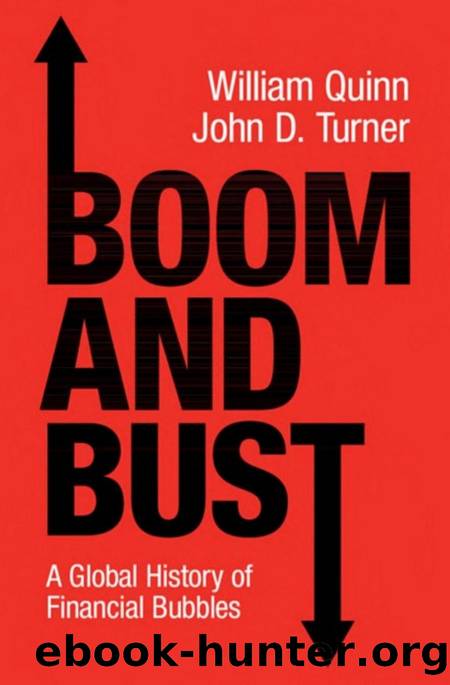Boom and bust a global history of financial bubbles by Quinn William Turner John

Author:Quinn, William Turner, John
Language: por
Format: mobi
Published: 2020-08-15T12:20:01+00:00
CHAPTER 9
The Dot-Com Bubble
Clearly, sustained low inflation implies less uncertainty about the future, and lower risk premiums imply higher prices of stocks and other earning assets . . .
But how do we know when irrational exuberance has unduly escalated asset values, which then become subject to unexpected and prolonged contractions as they have in Japan over the past decade?
Alan Greenspan, 19961
T hedismantlingofpost-warfinancialregulation
that led to the Japanese Bubble ushered in an era of abundant
marketability, money and credit. Securities became much more marketable as a result of the removal of restrictions on foreign ownership of firms and an accompanying boom in the use of derivatives, especially in the United States.2 The 1970s and 1980s saw a global decline in the use of capital controls and fixed exchange rates, making it easier than ever for money to cross borders. Restrictions on banking were gradually removed, giving banks, many of which were now operating internationally, unprecedented control over the level of credit. The global economy effectively became a giant tinderbox waiting for a spark and, as a result, the post-1980 period has seen major financial bubbles become remarkably common.
The first spark after the Japanese Bubble came from computer
technology â a literal spark, in one sense, since computing is the use of electrical currents to perform logical functions. In the post-war period this proved useful for a range of industrial and military applications, and by the end of the 1980s it had already had considerable economic impact. Its true potential, however, has turned out to be 152
THE DOT-COM BUBBLE
even greater, and it may even be the most consequential technology ever invented. The key to unlocking this potential, and the catalyst for the bubble, was the creation of a global network of information exchange: the now-ubiquitous Internet.
Although governments and universities had been developing net-
works of computers since the 1960s, the Internet as we now know it originated in 1989. Tim Berners-Lee, a scientist at the European Council for Nuclear Research, suggested that the organisation would find it easier to keep track of its projects if it had a system which structured information in an easily accessible way. Berners-Lee conceived of a decentralised system of documents, to which any member could upload data. These documents were then connected to one another by hyper-links. This âworld wide webâ, as Berners-Lee named it, was simply a way of connecting users and structuring information in order to increase productivity. But it created a feedback loop that exponentially increased the rate of technological change: computing technology was used to create better networks, and these networks allowed programmers to innovate more rapidly, thereby producing even larger and more efficient network systems. The more people used it, the more useful the technology became.
The world wide web was opened to the public in January 1991,
but at first grew relatively slowly.3 To those without a background in computing, it was quite inaccessible. This divide was bridged by browser technology, which provided a means of navigating the web.
Mosaic, launched in January 1993 by a 21-year-old computer science major called Marc Andreesen, represented a significant step forward.
Download
This site does not store any files on its server. We only index and link to content provided by other sites. Please contact the content providers to delete copyright contents if any and email us, we'll remove relevant links or contents immediately.
The Fifteen Biggest Lies about the Economy: And Everything Else the Right Doesn't Want You to Know about Taxes, Jobs, and Corporate America by Joshua Holland(817)
The World For Sale by Javier Blas(619)
The Economist (20210109) by calibre(566)
Made in China by Anna Qu(540)
Philippines--Culture Smart! by Culture Smart!(503)
Boom and bust a global history of financial bubbles by Quinn William Turner John(485)
The Dictatorship of Woke Capital by Stephen R. Soukup(483)
Big Money by Kenneth P. Vogel(482)
Forex Trading All In One For Dummies by Mishra Mamta(479)
The Money Revolution by Anne Boden(471)
Tax the Rich! by Morris Pearl(460)
Mission Economy by Mariana Mazzucato(457)
Cross Winds: Adventure and Entrepreneurship in the Russian Far East by Myers Steven(456)
The New Retirement Savings Time Bomb by Ed Slott(449)
The Inflation Myth and the Wonderful World of Deflation by Mark Mobius(435)
Fundamentals of Finance by Mustafa Akan Arman Teksin Tevfik(419)
The Great Demographic Reversal by Charles Goodhart & Manoj Pradhan(417)
How Finance Is Shaping the Economies of China, Japan, and Korea by Hugh Patrick(407)
Business Recoded by Peter Fisk(406)
